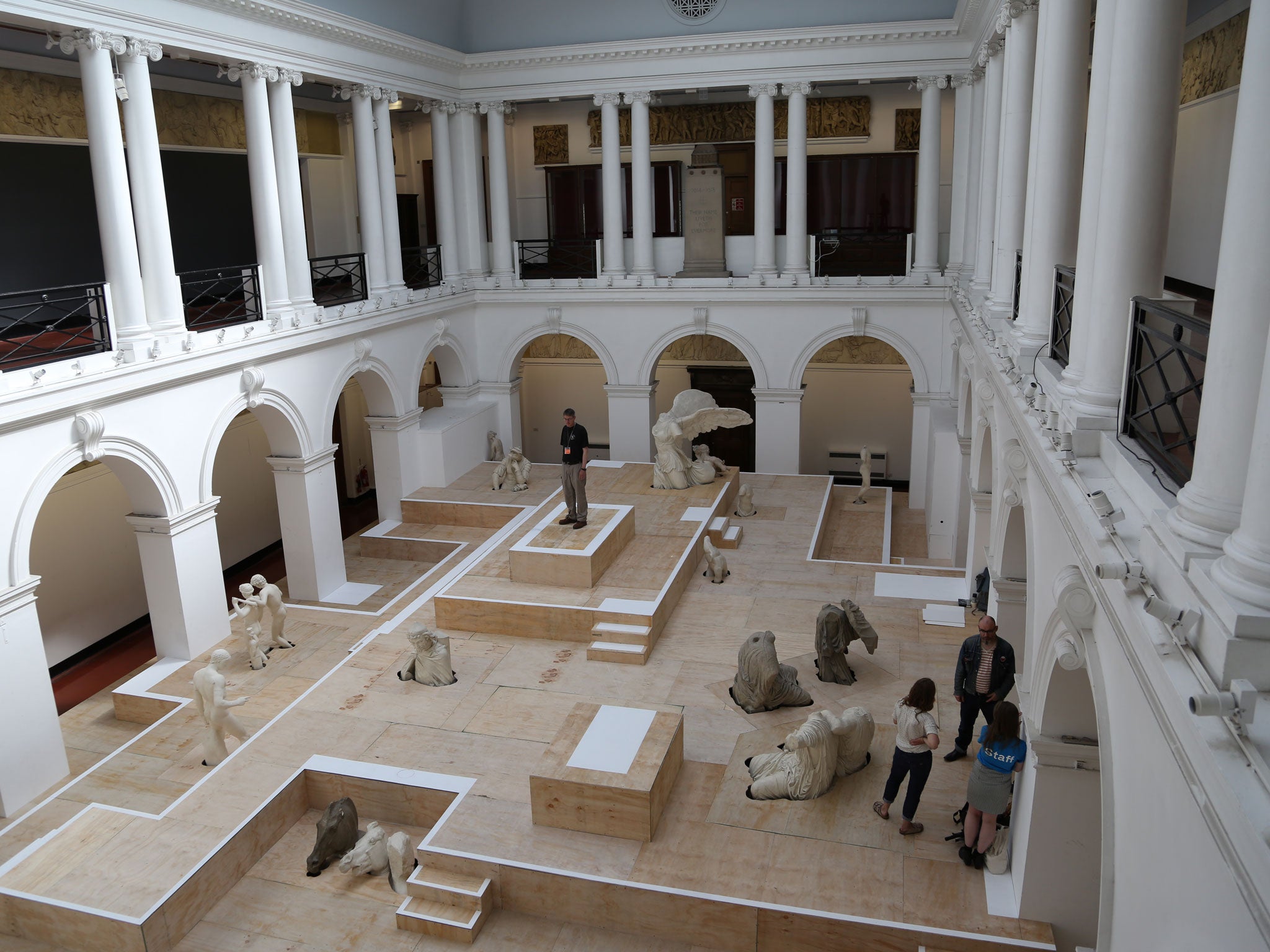Charles Darwent on the Edinburgh Art Festival: It's war and peace in the living room
Some of this year's most worthwhile shows are to be found in the most unlikely places

One joy of the Edinburgh Art Festival is being made to see work you know you're going to hate and finding, to your annoyance, that you don't. Thus, for 2013, Christine Borland and Brian Cody's Daughters of Decayed Tradesmen (New Calton Burial Ground, to 1 September).
On paper, this ticks every box for Darwent dislikeability. First, it is collaborative, the word "collaboration" appearing between "appropriation" and "intervention" in my index of tiresome art terms. Second, it seems over-conceptualised – the oral histories of ex-Trades Maiden hospitallers recorded on Jacquard punch cards, these hung like skeins of cloth in a cemetery tower. Too much; except not. For this kind of work to work, head, eye and heart have to come together, and, in Daughters of Decayed Tradesmen, they do. Borland and Cody's installation has the Jungian beauty of Angela Carter. I recommend it highly.
Peter Liversidge's doppelgänger (Ingleby Gallery, to 21 September) blurs the living and dead, Liversidge having remade a suite of etchings, Ein Handschuh (1881), from the Austrian Symbolist, Max Klinger. That's collaboration and appropriation: double-tsk.
Still, you sort of see the point. Appropriately for Edinburgh, Liversidge's grave-robbing has a faint whiff of Burke and Hare. Also of deep oddity, the titular glove in the blow-ups of Klinger's etchings materialising, in ghostly marble, on the floor in front of them. These are certainly more impressive than Liversidge's other festival offering, flags with the word HELLO on them flapping grimly around the city.
Krijn de Koning's Land (Edinburgh College of Art, to 1 September) is not so much collaborative as invasive, the Dutchman having taken over, as Dutchmen will, an entire art-school sculpture court. By moving the resident casts around and raising and lowering the floor, De Koning brings his dead subjects to life.
Disturbing life, it must be said – the winged Victory of Samothrace has sunk up to her waist in the new floor-plinth, while all that is left of one horse of Helios is a few sorry inches of mane. At once clever and moving, De Koning turns space into time, casting the college sculptures in a drama of their own forgetting, re-writing history as tragi-comedy. Asked by the artist what they thought of their casts, students at the college replied that they never looked at them. They will now.
Central to this Festival's collaborative theme is an exhibition called Mostly West (Inverleith House, to 22 September) – a title that gives the game away, all the works in it having been made by Franz West with other people. A believer in art as a group activity, the Austrian, who died last year, worked in this and that – chicken wire found favour for a time, as did papier mâché. In the 1990s, he made sculptures that resembled frankfurters, and were meant to. "It doesn't matter what art looks like, but how it is used," West said.
And so, at the top of the stairs, is Spaghetti West, a Mexican bandit made out cigarettes by Sarah Lucas. (This bandido is dangerous. A packet on the floor below says, "Smoking kills.") Except that he isn't by Lucas, but by Lucas and West. ¿Que? Exactly. If I understand West correctly, it takes two to make art, an artist and a viewer. Why not, then, two artists and a viewer, or any permutation of these? Others agreed with him, the roll call of part-West artists being impressive – Albert Oehlen, Jannis Kounellis, Richard Artschwager, Michelangelo Pistoletto, et cetera. Seen together, a collective collective, the works in Mostly West make a deeply subversive claim: that art may be ordinary, and artists, too. I can't pretend I feel West, but I do admire him; maybe even love him a little.
The only collaboration I could find at Fiona Banner's The Vanity Press (Summerhall, to 27 September) was a neon ampersand linking the show to Lawrence Weiner's next door. That'll do, I suppose. As with West and Liversidge, Banner's work questions the worth of originality: her art is often made out of other people's, and there is a stack of "original" Banners to take away for free.
There's no questioning the originality of her three new films in this show, though, most notably Chinook, in which a military helicopter performs a sinister aerial ballet. You'll recall the Harrier jump jet Banner installed in Tate Britain in 2011, its mix of pathos and threat.
Chinook's aerobatic set pieces – Double Dipper, Begging Dog, Arse in the Grass – bring these same qualities to a life so scary as to be barely watchable.
It is in the nature of the Edinburgh Festival that the least obvious things are often the most worthwhile, and so I refer you to the front room of Rose Frain, an artist, like Banner, with an abiding horror of war. (By appointment, www.rosefrain.com.) Frain uses the language of domestic Edinburgh to question conflict, Afghanistan being her latest fascination. The hearth stone of her fireplace, lightly rubbed with rust, becomes the story of all wars, of the women they preternaturally effect. Make time to go.
Critic's Choice
Step into the colourful world of Patrick Caulfield in this major survey of the artist’s work at Tate Britain (to 1 Sept). Caulfield, who died in 2005, came to prominence in the 1960s after studying at the Royal College of Art alongside David Hockney. Although often labelled as Pop, Caulfield preferred to see his bright still-lives and interiors as following in the formal tradition of Braque and Gris.
Subscribe to Independent Premium to bookmark this article
Want to bookmark your favourite articles and stories to read or reference later? Start your Independent Premium subscription today.

Join our commenting forum
Join thought-provoking conversations, follow other Independent readers and see their replies